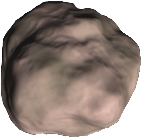Difference between revisions of "Moon/ru"
(→Обратите внимание) |
|||
| Line 36: | Line 36: | ||
|} | |} | ||
== Обратите внимание == | == Обратите внимание == | ||
| − | * [[:Category:Moons]], | + | * Категория "[[:Category:Moons/ru]]", содержит в себе все статьи о лунах; |
| − | * {{ | + | * {{W:ru:Спутник (космос)|Естественный спутник}}; |
| − | * {{ | + | * {{W:Asteroid capture|Статья "Захват астероида" в Википедии}}. |
| + | |||
== Ссылки == | == Ссылки == | ||
<references /> | <references /> | ||
[[Category:Moons]][[Category:Moons/ru]] | [[Category:Moons]][[Category:Moons/ru]] | ||
Revision as of 10:09, 9 September 2014
Луна (англ. "moon") или естественный спутник (англ. "natural satellite") - это небесное тело, движущееся по орбите вокруг другого, большего, небесного тела, не являющегося звездой. В то время как в реальном мире разнообразные типы небесных тел имеют луны, в Космической Программе Кербала только пять самых больших планет имеют луны, предопределенные в игре. Существует возможность создания дополнительных лун, используя динамически генерируемые астероиды.
Irregularity
Moons are either defined as regular moons or irregular moons depending on the orbital characteristics. Most of them are regular moons, because they orbits have a low eccentricity and inclination. The moons Gilly, Bop and Pol are the most irregular predefined moons. It should be noted that this differentiation is made by observations and are not officially documented in the game. There is no difference between them and other celestial bodies in terms of game mechanics.
There are various properties to differentiate between both types and the properties are opposing. For example regular moons have a low eccentricity while irregular moons have usually high eccentricities. Apart from the eccentricity irregular moons have also high inclinations, a low mass ratio to the body they orbit and are uneven. Generally irregular moons have also a lower mass than their regular counterparts which results in a lower surface gravity, although they are smaller. Sometimes there is a ratio between the sphere of influence and semi-major axis mentioned, which is the same as the mass ratio raised to the power of ⅖.

The moons Gilly, Bop and Pol are considered irregular moons, because most of the defining properties are distinctly different than those from the regular moons. Only the irregular moons, except for Ike which is considered a regular moon, no eccentricity but even Ike's eccentricity is small compared to the irregular moons.
Because it is believed in the real-world science that most irregular moons are captured asteroids, they are sometimes called captured asteroids. But they are different with dynamically generated asteroids which were captured, because dynamically generated asteroids are even smaller than predefined ones.[1] They also don't have a gravitational field, which makes them different from moons in terms of celestial mechanics.
Moon comparison
The following table shows those properties for all moons, with irregular moons highlighted. For the mass ratio, eccentricity and unevenness all irregular moons are grouping together and the difference to the closest regular moon is good observable. Only the regular moon Ike has a higher inclination. Another regular moon Minmus has a smaller radius, lower mass and surface gravity than Bop. The unevenness is the quotient of the highest point divided by the radius. An unevenness of 0.01 means, that the highest mountain is as high as 1% of the complete radius (as the highest point data isn't complete those unevenness values denoted as n/a).
| Moon | Radius (km) | Mass (kg) | Mass ratio | Eccentricity | Inclination (°) | Unevenness | Surface gravity (m/s²) |
|---|---|---|---|---|---|---|---|
| |
13.00 | 1,2420×1017 | 0.00000100 | 0.550 | 12.00 | 0.4923 | 0.05 |
| |
200.00 | 9,7599×1020 | 0.01844440 | 0.000 | 0.00 | 0.0353 | 1.63 |
| |
60.00 | 2,6458×1019 | 0.00050000 | 0.000 | 6.00 | 0.0954 | 0.49 |
| |
130.00 | 2,7822×1020 | 0.06161460 | 0.030 | 0.20 | n/a | 1.10 |
| |
500.00 | 2,9397×1022 | 0.00694440 | 0.000 | 0.00 | n/a | 7.85 |
| |
300.00 | 3,1088×1021 | 0.00073440 | 0.000 | 0.00 | 0.0266 | 2.31 |
| |
600.00 | 4,2332×1022 | 0.01000000 | 0.000 | 0.03 | n/a | 7.85 |
| |
65.00 | 3,7261×1019 | 0.00000880 | 0.235 | 15.00 | 0.3347 | 0.59 |
| |
44.00 | 1,0814×1019 | 0.00000260 | 0.171 | 4.25 | 0.1271 | 0.37 |
Обратите внимание
- Категория "Category:Moons/ru", содержит в себе все статьи о лунах;
- {{W:ru:Спутник (космос)|Естественный спутник}};
- {{W:Asteroid capture|Статья "Захват астероида" в Википедии}}.
Ссылки
- ↑ “Asteroid Redirect Mission - The FAQ” by Rowsdower released on March 14th

